Main Points Considered A New Zealand Citizen living in Australia, do they qualify for the First Home Owners Grant (FHOG) Also, can they qualify for the First Home Owners Stamp Duty Concessions What if they rent out the spare bedroom to help pay the mortgage? Scenario...
Main Residence 2 Year Rule for an inherited property
 A client inherited a property from her late parents which was used as their Principal Home. The parent’s family home has been transferred to her as part of the estate. The two year period is now coming due as such she needs to determine what are the capital gains issue if she sells before the 2 years from the date of death is up, or if not what are the apportionment for CGT thereafter.
A client inherited a property from her late parents which was used as their Principal Home. The parent’s family home has been transferred to her as part of the estate. The two year period is now coming due as such she needs to determine what are the capital gains issue if she sells before the 2 years from the date of death is up, or if not what are the apportionment for CGT thereafter.
Full Exemption
Under section 118-195 ITAA 1997, a full exemption can apply on sale of a dwelling inherited from a deceased individual if the property was the deceased’s main residence just before their death and was not being used to produce income at that time and either:
- The property is sold within 2 years of the date of death (the Commissioner can extend this period); or
- The property has been the main residence of the deceased’s spouse, someone granted a right to live in the property under the terms of the deceased’s will or the individual beneficiary who is selling the property from the date of death until the property is sold.
Partial Exemption
The partial exemption rules in section 118-200 apportion the capital gain based on the number of days that the property was not the main residence of the beneficiary since it was acquired from the deceased if this period is over 2 years
How to calculate the Partial Exemption under CGT
Example: Part exemption
Vicki bought a house under a contract that settled on 12 February 1995 and used it solely as a rental property. When she died on 17 November 1998, the house became the main residence of her beneficiary, Lesley. Lesley sold the property under a contract that settled on 27 November 2016.
As Vicki had never used the property as her main residence, Lesley can’t claim a full exemption from CGT. However, as Lesley used the house as her main residence, she’s entitled to a part exemption from CGT.
Vicki owned the house for 1,375 days and Lesley then lived in the house for 6,586 days, a total of 7,961 days. Assuming Lesley made a capital gain of $200,000, the taxable portion is:
$200,000 × (1,375 ÷ 7,961) = $34,544
As Lesley is taken to have acquired the property before 21 September 1999 and entered into the contract to sell it after that time, and held the property for at least 12 months, she can use either the indexation or discount method to calculate her capital gain.
End of example
If you dispose of your ownership interest in the dwelling within two years of the person’s death, you can ignore the main residence days and total days during your period of ownership.
You ignore any non-main residence days before the deceased’s death if:
- the dwelling passed to you after 20 August 1996, and
- just before the deceased died it was their main residence and was not being used to produce income.
The 2 year period is calculated from the date of death to the date of settlement rather than the date of contract of sale of the deceased parents home.
Example: Continuing main residence status
Aldo bought a house in March 1995 and lived in it. He moved into a nursing home in December 2010 and left the house vacant. He chose to treat the house as his main residence after he ceased living in it, under the ‘continuing main residence status after moving out’ rule.
Aldo died in February 2016 and the house passed to his beneficiary, Con, who used the house as a rental property.
As the house was Aldo’s main residence immediately before his death and was not being used to produce income at that time, Con can obtain a full exemption for the period Aldo owned it.
If:
- Con rented out the house and sold it more than two years after Aldo’s death, the capital gain for the period from the date of Aldo’s death until Con sells it is taxable
- Con sold the house within two years of Aldo’s death, he can ignore the main residence days and total days between Aldo’s death and him selling it, which would give him exemption for this period
- Aldo had rented out the house after he stopped living in it he could still have chosen to treat it as his main residence – the house would be treated as his main residence until his death because he would have rented it out for less than six years – in which case Con would still get an exemption for the period Aldo owned the house.
Use the flowchart link to work out if your inherited dwelling is exempt from CGT.
First Home Owner Grant and Stamp Duty Concessions for a NZ Citizen in VIC, QLD, and NSW
Main Points Considered A New Zealand Citizen living in Australia, do they qualify for the First Home Owners Grant (FHOG) Also, can they qualify for the First Home Owners Stamp Duty Concessions What if they rent out the spare bedroom to help pay the mortgage? Scenario...
Australian Homeowner Moving Overseas and Selling Their Principal Place of Residence (PPR) – Avoiding a $295,200 CGT Bill
Principal Place of Residence Exemption Loss if Sold While Overseas Summary of how the Principal Place of Residence (PPR) Exemption is impacted by moving overseas. When Australian homeowners move overseas and become non-residents for tax purposes, selling their...
Investment Property Capital Gains Tax (CGT) Calculation with PPR Transition
Having an investment property prior or posted to it being a principal place of residence has tricky CGT Calculations. Capital Gains Tax (CGT) is an essential consideration for property owners when selling a property used for different purposes over time. This blog...
Understanding Land Tax in Australia
Picture of a vacant block of land to illustrate it may be subject to land tax What is Land Tax? Land tax is a state and territory-imposed tax on the unimproved value of taxable land owned by individuals, companies, and trusts. It is calculated annually based on a...
Tiny homes have excellent rental yields, income streaming and tax minimisation strategies. How do they compare to a Granny Flat?
What are the tax and investment considerations for a Granny Flat above versus a Tiny Home below? Income Tax Return Reporting - Income Streaming Tiny Homes Tiny home ownership does not have to follow the ownership interest of the underlying property ownership. For...
Easier for Victoricans to build Granny Flats from December 2023.
Secondary Dwelling From December 2023 the Victorian Government has passed planning changes to make it easier to build Granny Flats - or "small secondary dwellings", on existing homes. The Victorian Premier Jacinta Allan revealed that planning permits will no longer be...
Property Investors to ensure income and expenses are correct.
The ATO is particularly targeting property investors that are not using the help of a specialist property tax accountant like Umbrella Property Accountant, due to the high error rate being discovered from ATO Audits. The ATO Audits into self-preparers have uncovered...
Residential Rental Caps & Vacancy Taxes will help supply for tenants?
Gold Coast - Example of the Housing Rental Competing Forces Many Apartments are sitting empty most of the year, including an entire beachfront tower. Gold Coast mayor Tom Tate cited an entire high-rise sitting empty in the triple tower Jewel development at Surfers...
Victorian Labour Government Land Tax Hikes to push up Rents
Victoria was the most locked-down state in Australia, if not the world during Covid, resulting in the Victorian Government accruing over $30 Billion in debt to keep the doors closed. Victorian Statement Government wants to raise $8.6 Billion over the next 4 years by...
Joint Venture(JV) Tax Considerations for Property Developers
Joint Venture tax understanding for property developers in Australia Joint Venture Agreement What is a (JV) for Property Development A joint venture (JV) is a cooperative agreement between two or more parties in which all parties contribute their resources (such as...



